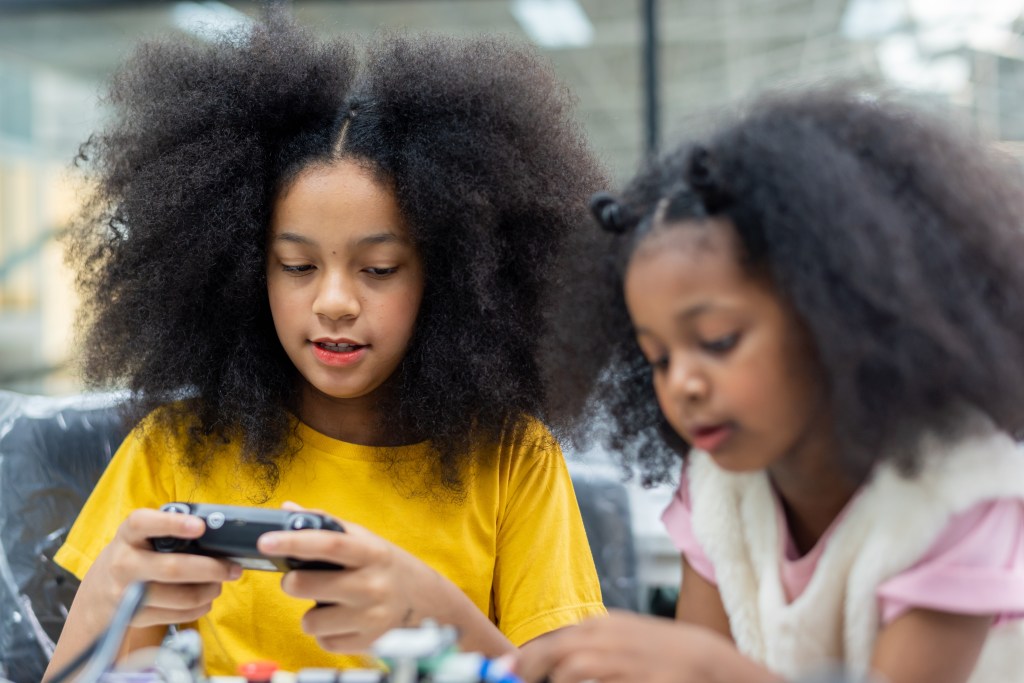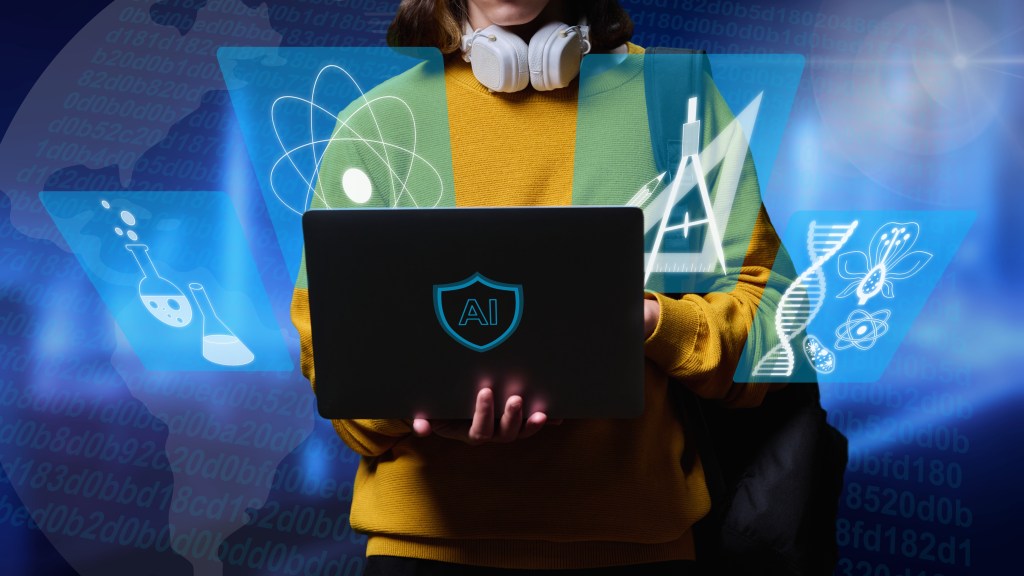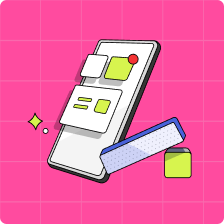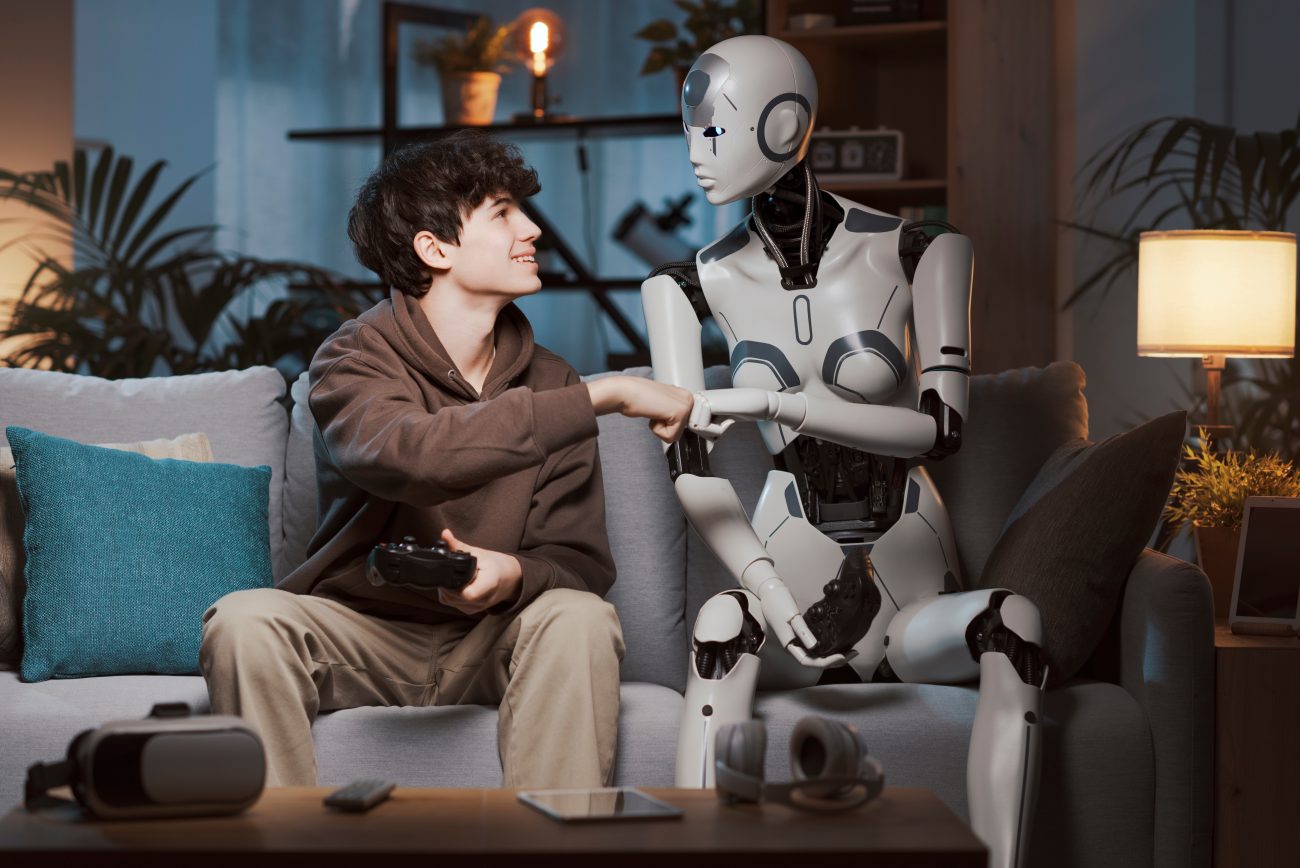Long before the Avengers’ Ultron came on the scene or Netflix’s The Mitchells were forced to go up against the machines, pop culture has been obsessed with artificial intelligence (AI).
In ancient times (1968) there was HAL, an AI robot who takes control of a spaceship mid-voyage in the movie 2001: A Space Odyssey. Blade Runner, The Matrix, and I, Robot all pitted humanity against AI-powered machines. Back then, real-world artificial intelligence seemed like a long way off. Now it’s here, and will probably be landing on toy shelves very soon, in the form of teddy bears that run on ChatGPT.
You’ve probably never envisioned our robot overlords arriving in the form of a Furby bent on world domination or worried about a tech takeover by a network of Tamagotchis tricked out with AI capabilities, but concerns about artificial intelligence are real.
At the same time AI is a powerful tool that we can use to our benefit—it’s not “good” or “bad” but the way that we use it can certainly have positive and negative outcomes and effects.
For kids, AI can help with homework, language learning, and research. It can spur creativity and increase accessibility while getting young people interested in science and technology. But there are downsides including privacy concerns and the proliferation of harmful misinformation.
It’s important for parents to be informed about AI so they can ensure that the experiences kids have with this rapidly developing technology can be positive and safe ones.
What is artificial intelligence or AI?
Good question. Let’s ask one of the most popular AI tools: ChatGPT.
Chat GPT says that artificial intelligence is “the simulation of human intelligence processes by computer systems” and that it “enables machines to perform tasks that typically require human intelligence, such as understanding natural language, recognizing patterns, solving complex problems, making decisions, and learning from experience.”
But that’s just a sliver of the big picture and it doesn’t tell us anything about where AI comes from. Back in 1950 Alan Turing, known as the father of computer science, put it quite simply when he asked “Can machines think?” The Turing Test was used by humans to try to differentiate between machine responses to questions and human responses. Early so-called AI consisted of chatbots equipped with a set of predetermined responses that created a narrow window in which they were able to engage with humans. Their abilities weren’t anywhere close to actual thinking.
Today, however, the answer to that old question is yes. Using a type of program called a large language model which operated by scraping vast amounts of text from the internet, Google’s AI passed the Turing Test in 2022. Now the debate over AI centres on whether it is actually “thinking” or whether it’s just really good at fooling us to believe that it is.
In short, we need a new test!
How are teens and students using AI?
Whether it’s truly thinking or not, what’s remarkable about this current wave of AI development is its facility with natural language processing and its capabilities in terms of learning alternate “languages” like the ones used to program code or understand molecular biology.
For teens and students, AI can be a powerful learning tool that gives them access to resources from across the globe and delivers these resources in an accessible way, no matter where they live.
Some of the common ways that teens are using artificial intelligence include:

Help with schoolwork or to learn new skills
AI offers homework assistants and other personalized learning tools that can support students in self-directed, extra-curricular learning (for example, studying a new language) or give them extra help in school subjects where they might struggle (like assisting them with a physics assignment).
Tweak or enhance their social media content
Teens are using AI programs to apply filters to photos or to edit images and videos destined for TikTok or Instagram.
Improve their writing and editing skills
AI can be used to point out spelling and grammar errors in essays and school assignments. It can also show students how to correct these errors.
Do research for school assignments
AI tools can pull together research from all across the internet and collect it in a single document or article. It’s a faster (though sometimes less reliable) method than conducting repeated search engine queries.
What are some common AI tools for teens?
It’s likely that your teen is already using AI in some shape or form (whether they recognize this fact or not). These are some of the tools they might be engaging with.
ChatGPT
This is the AI tool making headlines right now. ChatGPT exists online as a standalone tool but it’s also used to power external chatbots and other programs. Teens can use ChatGPT by providing it with simple prompts like “What is ChatGPT?” or by giving it more specific requests like “Tell me about the early life of the green sea turtle in the voice of David Attenborough” or “Write me a poem about SnapChat that sounds like a Taylor Swift song.” The levels of success with which the program completes these tasks vary. Widely.
However, ChatGPT can be a great tool for kids looking for a jumping off point or a little bit of direction when they’re starting an essay or research project. It can help them to structure an essay or explain a math problem they aren’t quite grasping. It can also encourage self-directed learning since kids can type in almost any prompt and get a mini lesson on the subject in return.
Google AIY
For kids who want to get hands-on with AI, Google’s AIY Projects are a great entry point. These DIY hardware kits allow kids and teens to build their own working AI-powered speaker or camera that connects to Google Assistant or Cloud Speech-to-Text. These projects can be put to practical use, allowing kids to use them to play games or perform internet searches.

Machine Learning for Kids
A great one for gamers and budding game designers, this AI program skews towards younger kids. It’s a next step for kids who may have already used Scratch to learn simple coding. Here, they get practical experience and an understanding of machine learning. By building a game through this free online program, they’ll get to see how machines learn and how to create games based on this concept.
Quizlet
Quizlet is a collection of AI-enhanced tools designed to help kids study. There are several elements available to use. One takes class notes and turns them into flashcards and quizzes to help kids prepare for tests. Another element is a chatbot that can converse with users about the topic they’re studying, ask them questions, and provide help with concepts they’re struggling to understand. Students can enter prompts like “Can you explain this differently?” or “Can you give me a practice problem?” and the chatbot will comply. It’s like a tutor, only powered by artificial intelligence.
Bing AI Search
Microsoft says that the new Bing reinvents the search engine and while this might be a slightly grandiose claim, Bing does provide better organized and more relevant search results while also offering the option to chat with their bot about the subject you’re researching. Like ChatGPT, teens can use Bing to research school projects. (They can also use it to look up which new video game they should try next if their favourite game is Fortnite.) It operates like a search engine but with AI extras.
Midjourney & Dall-E
Both Midjourney and Dall-E take text prompts and produce images based on them. Unlike the tools we’ve talked about above, neither of these AI image generators are free. Midjourney has several subscription tiers ranging from $10 to $120 USD per month and Dall-E charges per image generated, operating on a credit system. The images that are produced from either program are based on images that already exist on the internet. In some cases these images may be inappropriate for kids and teens. However, the tools can also be used by teens to edit photos of their own.
Grammarly
Grammarly is a free writing assistant that can help teens correct errors in their writing, ranging from spelling mistakes to the clarity of their ideas and arguments. It can be used to write a professional email or put together a resume as well as for school work.
Attention students: Grammarly can also be used by educators to detect plagiarism!
Duolingo and Memrise’s MemBot
These two tools make new languages fun and engaging for teens by using AI to create personalized paths for learning and retention. Duolingo is a gamified way to learn to speak one of the 40 languages in its database while Memrise’s MemBot allows language learners to practice their conversation skills without a (possibly intimidating) audience.
What are the pros and cons of kids and teens using AI?
Like we said from the start, AI isn’t good or bad, it depends on the boundaries you set and the way kids and teens use it.
The pros of AI tools for students
- Personalized and tailored educational experiences that support a student’s individual needs and learning style.
- Increased accessibility for students who live with a disability (think: text-to-speech options for teens with visual impairment)
- The ability to generate ideas or starting points for teens to build on, inspiring creativity
- The use of AI can result in an increased interest in science and technology
The cons of AI tools for students
- Like with so many of the tech tools that make our lives easier or more fun, AI comes with privacy and data protection concerns
- Students might develop a dependency on AI to assist them with their school work which can steer them away from critical, independent thinking
- Bias is inherent in AI tools and can lead users towards misinformation or feedback loops
- Occasionally AI provides users with results that border on nonsensical, like when Microsoft’s AI-generated travel guide told visitors to Ottawa to go to the local food bank for a meal

Tips to keep kids and teens safe using AI tools
If your teen is using AI tools for school or in their free time, be sure to talk to them about both the strengths and weaknesses of this rapidly evolving tech. Provide them with clear boundaries about when and where it’s appropriate to use AI (To help explain a math problem? Yes. To write your history essay for you? Probably not).
Advise them to keep their personal data and sensitive information protected (in the same way they do when they use social media) and let them know that images of their own face are part of that personal data and that giving AI access to their personal images may have consequences in the future.
Parents should try to keep up to date with new developments in AI (and in tech in general) because we know that our kids are doing just that. Mydoh aims to support parents in raising money-smart and tech-smart kids. By staying informed on the subject of artificial intelligence, parents can be in step with kids and teens as they embrace their digital future.
Download Mydoh and help build the foundation of financial literacy for your kids and teenagers.
This article offers general information only and is not intended as legal, financial or other professional advice. A professional advisor should be consulted regarding your specific situation. While the information presented is believed to be factual and current, its accuracy is not guaranteed and it should not be regarded as a complete analysis of the subjects discussed. All expressions of opinion reflect the judgment of the author(s) as of the date of publication and are subject to change. No endorsement of any third parties or their advice, opinions, information, products or services is expressly given or implied by Royal Bank of Canada or its affiliates.








